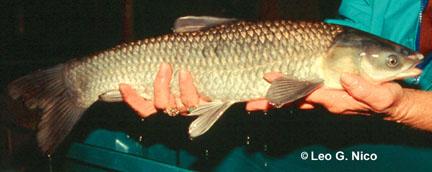Black Carp
-
Scientific Name
Mylopharyngodon piceus - Visit ITIS for full scientific classification.
-
Description
- Large, freshwater fish. Elongated body shape, similar in appearance to Grass Carp.
- Adults are black, dark blue, or brown on their back and sides, and light gray to white on their bellies.
- Large, smooth teeth in throat adapted to crush the shells of snails, mussels, and clams.
- Possible for individuals to grow over 5 feet long and up to 150 pounds.
-
Habitat
- Bottom dwellers, preferring floodplains and the backwaters of rivers. Also found in reservoirs, irrigation canals, and lakes.
- Black Carp can tolerate extreme environmental conditions including: low oxygen levels, brackish water, and temperatures ranging from 32-100 degrees F.
-
Invasion Pathways and Distribution
- In 1973, Black Carp were accidently introduced into a fish farm in Arkansas with a shipment of Grass Carp.
- They now occur in the Mississippi River and continue to spread to other surrounding states.
- Asian Carp can spread through fish farming activities, legal and illegal stocking, accidental inclusion in shipments, escape or release to open waters, and natural dispersal.
- Native to China and Russia.
- See USGS for a map of current U.S. distribution.
-
Life History
- Mating season begins in the summer when the water is warmer than 65 degrees F.
- Enormous reproductive capabilities. Females migrate to areas of moderate water flow in order to release hundreds of thousands of eggs into the water column.
-
Impacts
- Compete with native fishes for resources.
- Can reduce native populations of the snails, mussels, and clams they feed on.
- Black Carp also carry parasites and diseases that can then spread to native fishes.
-
References and Useful Links
For references by category and links to other useful AIS sites see our LEARN MORE page.

